Philips Automotive, your ultimate choice for the road ahead

Ultinon Essential LED
Up to 6500K
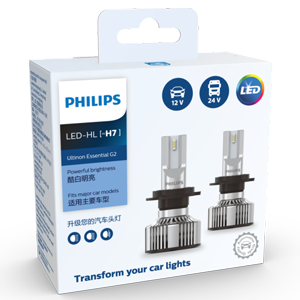
Available in:
LED-HL [H1], [H3], [H4], [H7], [HB3/4], [H11], [HIR2], LED-FL [H8/H11/H16]




Ultinon Pro5000 LED
Up to 160% brighter light*

Available in:
LED-HL [H1], [H3], [H4], [H7], [HB3/4], [H11], [HIR2], LED-FL [H8/H11/H16]

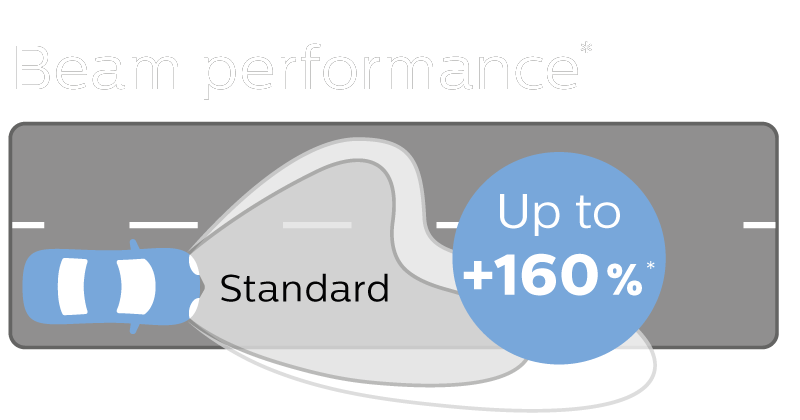


Ultinon Pro9000 LED
Up to 250% brighter light*
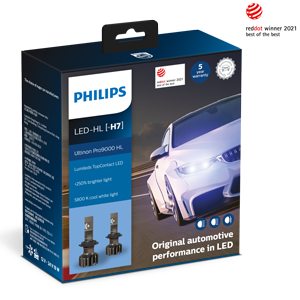
Available in:
LED-HL [H1], [H3], [H4], [H7], [HB3/4], [H11], [HIR2], LED-FL [H8/H11/H16]

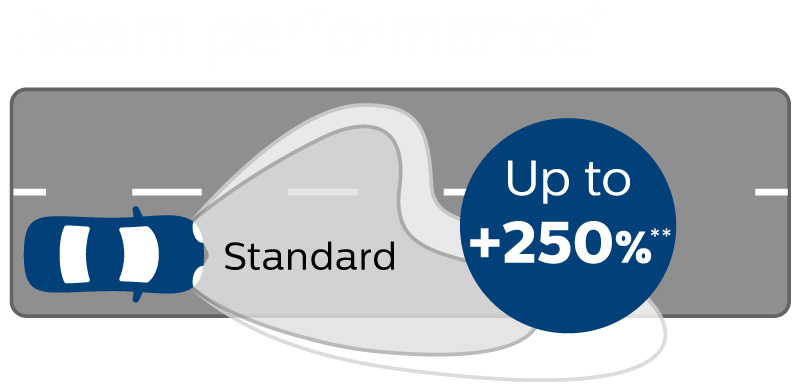














Images for illustration purposes only. Images for illustration purposes only * Light colour: “Up to”; Beam performance: compared to minimum legal standard ** Compared to the minimum legal standard Images for illustration purposes only * Light colour: “Up to”; Beam performance: compared to minimum legal standard ** Compared to the minimum legal standard
*Compared to the minimum legal standard for halogen bulbs. Up to +200% for Ultinon Pro9000 LED-HL [≈H1], and [≈H3] types

It is your own responsibility to ensure that the use of the LED retrofit lights complies with applicable local legal requirements.
Frequently asked questions (FAQ)
General information
- What is LED Upgrades? For which applications?
-
It’s a solution for the drivers who want to upgrade their lighting solutions to replace their halogen/conventional bulbs. In terms of applications, it has to be separated between interior and exterior lights:
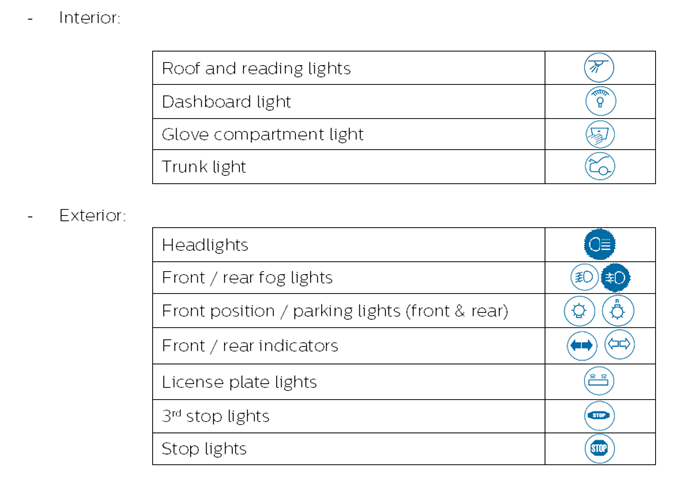
Interior:
- Roof and reading lights
- Dashboard light
- Glove compartment light
- Trunk light
Exterior:
- Headlights
- Front / rear fog lights
- Front position / parking lights (front & rear)
- Front / rear indicators
- License plate lights
3rd stop lights
Stop lights
- Roof and reading lights
- How do I know if the Philips LED Upgrades are compatible with my headlamp?
-
There are no spare power cables available for purchase. For the MDLS, there are single replacement units for sale.
- How can I verify which LED to use to replace my old bulb?
-
Each type is communicated with the corresponding ECE name. Here below the comparison table between halogen and LED retrofit:

- How the lifetime of an LED is calculated?
-
The most critical piece of an LED is the PCB (Printed Circuit Board) because it heats a lot and if not properly cooled down, its performance will decrease.
Therefore, we always calculate the lifetime of the LED based on this PCB (as opposed to the competition who’s generally claiming the lifetime of the LED chip itself in an ambient temperature room). - Can I save money by switching to LED?
-
Yes, Philips LED Upgrade bulbs has an extended lifetime, which means you save the cost and hassle of frequent bulb replacements which on average occur every 1-3 years. In addition, a LED bulb uses substantially less energy (e.g. halogen H4 consumes 55W where a LED-HL [≈H4] drawn around 20W).
- How could I differentiate fake Philips LED bulbs from a genuine?
-
Whenever you purchase a Philips LED Upgrade bulb for your headlights, you can check the authenticity online using the code provided on the anti-fake label. This is an insurance for you that you get a genuine Philips LED.
- What are the meaning of Philips AirFlux, AirCool, CeraLight and Safebeam?
-
Philips AirFlux and AirCool technologies: the latest thermal management systems with active and passive cooling systems for increased lifetime and performance. We use passive cooling when the spacing within the headlamp is big enough to effectively dissipate the heat without the risk of decreased performance. Also, depending on the performance of the LED, we would use either a passive or active cooling. For example, On LED-HL [≈H7] headlamp, the optic is generally smaller than LED-HL [≈H4]), so the heat dissipation needs to be active to effectively direct the hot air away from the back of the LED.
Philips CeraLight technology (specific to LED-T10, for X-tremeUltinon LED range): using ceramic components for best heat dissipation management to ensure highest durability in extreme conditions.
Philips SafeBeam technology: projects light exactly where you need it for your safety (no glare for oncoming racers). The Figure of Merit (FOM => light projected on the road) is in concordance with ECE R112. - What do these symbols on the packaging mean?
-
This symbol indicates that the product is not suitable for public roads. This means that it can only be used on “closed” roads.
This symbol shows that the product has not been approved according to the ECE R37 regulation on halogen bulbs. We show the halogen regulation because, although an LED retrofit bulb is designed to replace the halogen bulb in the very same headlamp unit, that does not mean the LED retrofit bulb is ECE R37-approved. - What does the following text mean: "It is your own responsibility to ensure that the use of LED Upgrade lights complies with relevant local legislation"?
-
This text is intended to ensure you use LED Upgrade bulbs correctly and in line with local laws. Local legislation is subject to change, so it is essential that that you check whether the product can be used where you are.
Technical information
- How to make sure my car can be equipped with LED Upgrades?
-
Not all the cars can be equipped with LED Upgrades. At Philips, we have tested a variety of cars which are the most representative in the Asian market, and for which we are confident that our bulbs can used properly.
- Why some Philips LED-HL have got a heat sink and some have got a fan?
-
Thermal management is the key parameter to ensure performance and lifetime. Philips, with its expertise in Automotive OEM, understand the requirements of the different car headlamps. Depending on the power of LED, amount of heat to dissipate, type and size of headlamps, Philips LED retrofit bulbs will use the most adapted thermal management system, being active or passive cooling. Philips internally designed three thermal management systems: Airflux, AirCool, and ThermaCool.
- Are Philips LED range environment friendly?
-
Yes, Philips LED Upgrade range contributes to environment protection by:
1. Significant energy saving, consuming less overall resources and emitting less CO₂
2. Fully compliant with RoHS / REACH, which means no hazardous materials which are harmful to the environment
3. Long service lifetime which means elimination of unnecessary replacement related waste and system costs, while reducing overall resource consumption.
- Why does this polarity issue occur with LED?
-
Regular incandescent bulbs can draw current in either direction, there are no "positive" or "negative" sides on the bulb. The bulb will work regardless of which direction it is inserted. LED bulbs, however, only draw current in one direction. Basically, this situation can be compared to batteries that have a positive and negative side. So if the LEDs are inserted incorrectly, they will not work. The solution is to simply flip the LED.
- Does the progressive on/off of exterior lamps on certain vehicles remain after installing LEDs?
-
Philips LED Upgrade range has been designed to perfectly replace the current light setup that is in the car. This meaning that the progressive shutting on or off functions will continue to function after LED installation.
- On the driver box of the LED lamp it says: “Caution: Do not touch – Hot surface”. How hot will this become? Is it getting this hot that it can damage cables or any other car parts under the hood?
-
We strongly recommend that the driver box is always attached safely with plastic ties provided to avoid to move while driving and that the box is attached on a metal part in case it gets hot.
Installation information
- How do I replace the incandescent bulb with a LED bulb? Is it difficult?
-
The entire Philips LED Upgrade range is a retrofit of halogen and conventional bulb, making it easy to replace. Just need to follow the guidance on or in the package, and making sure prior to purchase there is enough space into the bulb housing.
- After installing an LED light, I get an error message on the dashboard?
-
LEDs draw much lower wattage than conventional lights (lower power consumption).
Some cars are equipped with light detection system to warn the driver that one of the light has failed. In fact, the system sends electric impulses in the electrical system to check the functioning of lights. Hence when the systems checks, the power emissions are too low to be detected. In such cases, we have developed a CANbus adapter which converts the power and avoids any error message.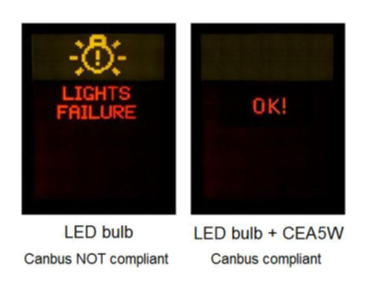
- The LED does not light up after installation. How can I resolve this issue?
-
If your Philips LED Upgrade doesn't light up, it’s likely that you need to "reverse the polarity" by flipping the LED. Philips LED Upgrade bulbs work like batteries with a positive and negative polarity. In case the Philips LED Upgrade does not light up, simply remove the LED, flip direction and reinstall as per explanation and illustration below:
1. Remove the Philips LED Upgrade from the socket
2. Flip the Philips LED Upgrade
3. Insert Philips LED Upgrade back into the socket
4. Check to ensure the Philips LED Upgrade lights up
- After installation of the LED, my car show fast flash errors as if my light is out or broken?
-
Error messages appear because the LED bulb wattage is much lower than conventional bulbs, which can make an outage warning system unable to detect the bulb.
If your car shows fast flash upon installation of an LED bulb, you may consider to purchase and install a Philips CAN-bus warning canceller solution. - After installation of the LED, my car does not start. What should I do?
-
After installation of LED bulbs, some cars go in limp mode. The LED has a different resistor value than an incandescent bulb, so the car’s computer is looking for the resistor value of the incandescent bulb. That is the reason why the car goes in limp mode after installing the LED: it notifies the driver that something is not working. Thankfully this happens rarely and the issue can be resolved. First verify that the limp mode is being caused by the LEDs by replacing them again with the incandescent bulbs. If the car works fine, the limp mode was most likely caused by the LED bulbs. This means that a load resistor, a CANbus adapter, is required.
- When installing an LED for turn indicators, is the blinking rhythm remains the same as for conventional or it becomes faster?
-
In each boxes of our turn indicators we provide two CANbus adapters that are necessary to install to ensure that the blinking of the LED remains at the same speed as the conventional lamp. If not installed, the LED blinking will be faster as if one of the bulb is broken.
Remember: always safely attached the CANbus adapter on a metal to avoid movement and damages for your vehicle.
- What does CANbus stand for?
-
It stands for Control Area Network Bus, and it monitors your vehicle’s conditions during operations. Most of the newest European models are equipped with CANbus, therefore we strongly advice to check with your dealer what’s the system within your car prior to purchases.
- Which CANbus adapter do I need?
-
Philips provide a range of Canbus adapters for the different car lighting applications:
The 5W CANbus is used when replacing a 5W conventional bulbs, typically for interior applications, license plate lighting, position light. The 21W CAN-bus is used to replace 20W conventional bulbs, for exterior signalling applications such stop, reverse and blinkers. - Does the CANbus removes the residual current at the time when the lamp goes off?
-
The Philips CANbus are designed to regulate the amount of wattage within the electrical system before it reaches the LED. When the LED is off, the remaining power is drawn by the CANbus. So that the LED stays off.
- How do I install a CANbus adapter?
-
If your car has a dashboard error message, experiences fast flash or goes in limp mode upon installation of an LED bulb, you may consider to purchase and install a Philips CANbus adapter solution.
See below image for installation instructions of the Philips CANbus adapter:

- Is it mandatory to use a CANbus adapter while fitting LED?
-
It’s strongly recommended to use a CANbus adapter to avoid either an excessive speed of the blinking or an error message on the dashboard.
- Even after installation of my LED with CANbus adapters, I still get an error message or flickering, what should I do?
-
Even if after proper installation of the LED Upgrade and the CANbus adapter in order to remove any flickering and/or error message on the dashboard, you still get the mentioned issues, it is best to go back to the original halogen bulbs and ask for reimbursement at your dealer.
